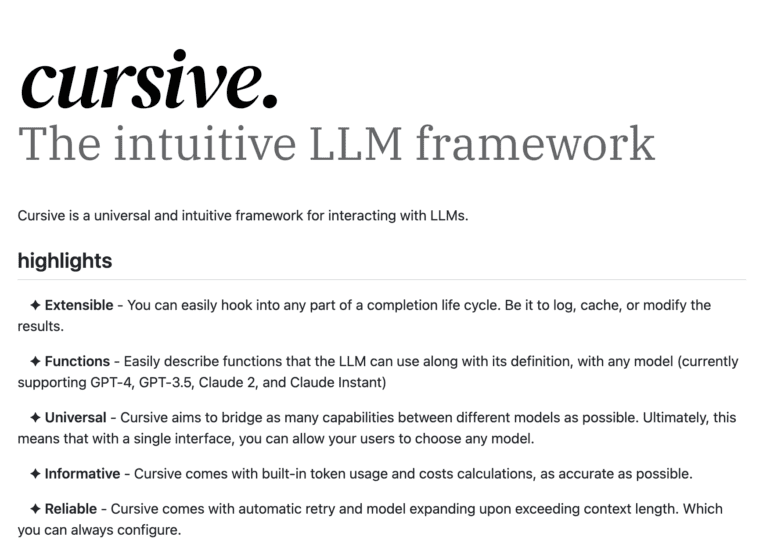TL;DR:
- Developers often face challenges when interfacing with Large Language Models (LLMs), struggling between complex frameworks and building abstractions from scratch.
- The Cursive framework aims to enhance Developer Experience (DX) with LLMs by providing a streamlined, intuitive, and adaptable solution.
- Cursive simplifies developer-LLM interaction, enabling effortless model queries and conversation threads.
- It introduces a coherent approach to function calling, improving code readability and maintainability.
- Tangible benefits include reduced code lines, instinctive function invocation, and accurate cost estimation across different models.
- Cursive’s introduction marks a significant advancement in LLM interaction, reshaping development processes and boosting productivity.
Main AI News:
In the intricate realm of Large Language Model (LLM) interaction, developers often grapple with a common and challenging dilemma. On one side of the spectrum lie complex and bloated frameworks, while on the other looms the daunting task of constructing numerous abstractions from the ground up. Striking the right balance between simplicity, ease of debugging, and scalability remains an ongoing uphill battle.
Traditionally, builders and developers engaged in the LLM domain have faced a recurring issue concerning frameworks. The spectrum spans from convoluted, feature-heavy frameworks that result in unwieldy code to a scarcity of proper tools and abstractions, compelling developers to expend substantial time on erecting customized solutions, inevitably impeding efficiency and productivity. These limitations have underscored an unmistakable demand for a framework that offers a streamlined experience without compromising on functionality.
Enter the solution to this challenge: the Cursive framework. With the unwavering objective of enhancing the Developer Experience (DX) when interacting with LLMs, Cursive emerges as a beacon of promise. Its vision revolves around redefining the landscape, making the process of LLM engagement intuitive, gratifying, and devoid of needless complexities. An exceptional feature of Cursive is its unparalleled adaptability across diverse JavaScript environments, spanning browsers, Node.js, Cloudflare Workers, Deno, Bun, and beyond.
Central to Cursive’s promise is its remarkable capability to simplify the interaction between developers and LLMs, fostering a seamless and gratifying experience. A striking example is its streamlined approach to querying the model and obtaining responses—a task that developers can now execute effortlessly with minimal code, thereby enhancing workflow efficiency. Moreover, maintaining a coherent conversation thread with the model is effortlessly intuitive, enabling a fluid exchange of ideas.
Not stopping there, Cursive introduces a groundbreaking innovation in the way functions are invoked within the LLM context. Traditional function calls often result in fragmented code that proves cumbersome to follow. Cursive disrupts this norm by introducing a function-calling paradigm that preserves coherence throughout the entire process. From crafting function definitions to execution and result retrieval, the integration is seamless, significantly enhancing code legibility and maintainability.
The resounding impact of Cursive is quantified through tangible metrics that reflect an elevated DX and streamlined development workflows. Reduced lines of code required for model interaction, an instinctive approach to function invocation, and a harmonious handling of conversations all contribute to amplified developer productivity. Moreover, the framework’s unique ability to estimate costs and usage across different models, coupled with its adeptness at context switching between models, introduces a level of dependability and observability that was hitherto absent.
The arrival of Cursive heralds a monumental leap forward in the realm of LLM interaction. With a paramount focus on elevating the developer experience, this framework tackles existing challenges head-on, paving the way for more efficient, straightforward, and gratifying development processes. Positioned as a transformative tool for reshaping the developer-LLM interface, Cursive holds the potential to redefine established norms, foster innovation, and significantly amplify productivity throughout the development landscape. Its versatility across a spectrum of JavaScript environments further cements its status as a game-changing solution for a multitude of developers.
Conclusion:
The introduction of the Cursive framework presents a transformative shift in the LLM interaction landscape. By addressing key challenges and offering tangible enhancements to the developer experience, Cursive paves the way for more efficient, intuitive, and productive development workflows. This innovation is poised to reshape industry practices, foster innovation, and elevate overall productivity in the developer community.

